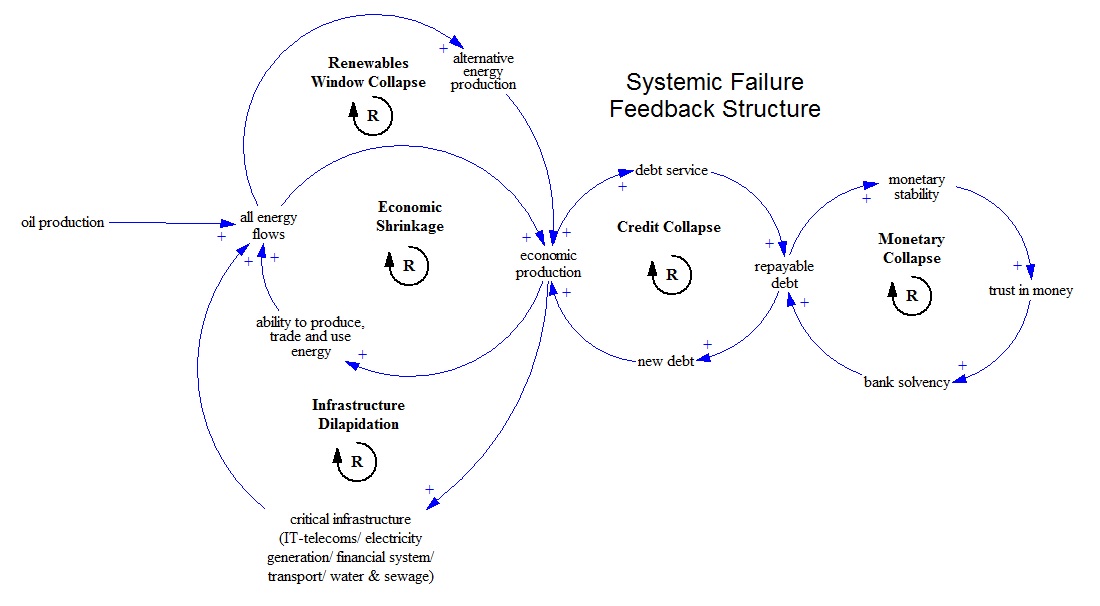« What is Sustainable? | Home | Mass deception and the quest for a more sustainable agriculture »
The Pace of Descent: A Long Emergency vs. Sudden Collapse
By Karl North | January 17, 2018
Students of the energy descent continue to debate the probability of different rates of industrial decline. Sudden collapse advocates focus on the increase of many kinds of fragility in the global industrial economy. Risk analyst Nassim Nicholas Taleb (Antifragile, The Black Swan) and others argue that increasing fragility is inherent with increasing complexity in systems due to randomness, uncertainty and the limits of knowledge. David Korowicz in Tipping Point described how a number of elements of fragility could lead to sudden collapse. I summarized his work in The Case for a Disorderly Descent.
Early adherents of slow decline describe a process in which industrial society gradually adapts as it chews through a massive backlog of built assets that cushion the decline, as described by James Kunstler in The Long Emergency or John Michael Greer in The Long Descent. These perspectives rely on historical patterns of how societies adapt to disastrous situations, usually via increased governmental intervention in economies, as in the US war economy and German national socialism in WWII, and the Special Period in Cuba due to the loss of energy and other industrial inputs from the USSR.
Increasing awareness of how interdependence causes things to change over time in complex systems has strengthened support for scenarios of sudden change. Interdependence of feedback loops can cause exponential change in one loop to infect others in a cascade. Hence the total effect is much greater, as in this model of some of the potential effects of decreasing oil production (click to enlarge):
This has led to a convergence of views on the pace, or at least the shape of the energy descent – toward a bumpy stairway scenario, illustrated metaphorically by Pooh Bear in this classic Christopher Robin scenario:
In The Ecotechnic Future, Greer’s latest version of his theory of catabolic collapse, he expects the declining energy will force society to flexibly adapt, gradually using up the built capital, but he now accepts the probability of a ragged descent likely punctuated with sudden shocks due to “trophic cascades”. I have summarized Greer’s points in Scenarios on the Downslope: Insights from Greer’s The Ecotechnic Future.
Some of the influences that have been advanced to suggest faster or slower change are:
Faster
- The so-called Seneca Cliff, in which declining net energy makes a civilization fall faster that it has risen.
- The industrial economy and infrastructure that is necessary to permit proposed technological palliatives is shrinking and will close off most such options. Korowitz: “Once collapse begins we will lose the tools and infrastructure we would need to manage the collapse”[1]
- A low- or no-growth economy can no longer pay the interest that capitalism requires to provide capital for growth or even maintenance of the economy.
- Tightly coupled supply chains in the present global economy cause a cascading collapse.
- Lock-in effects trap society in unsustainable systems like large scale institutions, automotive transportation and its suburban topography, industrial agriculture and its short cuts to fertility and just-in-time distribution, which impede transition to more viable lower energy ways of life, then cause sudden, costly collapse.
- In the present situation of fragility, damage to the industrial resource base from man-made or natural disasters can set off vicious spirals.
Slower
- The enormous waste and extravagance that capitalism tends to produce mitigates the collapse: it gives a society time to gradually let go of this accretion of discretionary consumption before it must suffer loss of necessities like food and shelter.
- In the attempt to sustain profits in the energy descent, capitalists will be compelled to adapt production to what is affordable to the average consumer, a pressure that could lead to more sustainable technologies in the whole economy.
- The salvage stage that Greer writes about also slows the decline, and includes not only physical remains but the accumulation of knowledge of living systems. In Cuba’s transition, for example, agroecologists and peasant farmers combined scientific and experiential knowledge to replace industrial agriculture with highly productive low input systems.
Conclusion
Our tendency so far to cling to what Greer calls wasteful abundance suggests a probable future where rising scarcity makes much such consumption unaffordable, causes demand destruction starting with the most discretionary consumption, and forces economic investment in directions that are more affordable for the majority of society. Thus begins a painful transition, slowed by cultural inertia that prolongs overshoot until some part of the no longer viable cheap energy economy suddenly gives way – a financial crash, electrical grid failure, supply chain failure, etc. Therefore, the downslope is likely to be punctuated with occasional shocks. Due to interdependency and fragility of system elements, chain reactions triggering cascades of change are likely, and hard to predict.
[1] Korowitz, http://www.feasta.org/documents/risk_resilience/Tipping_Point.pdf
Topics: Social Futures, Peak Oil, Relocalization, Uncategorized | 1 Comment »



January 17th, 2018 at 7:53 am
Another excellent post, Karl. I’ve long thought that there was little conflict between Greer’s vision of catabolic collapse and Bardi’s notion of a Seneca collapse. I love your overview of the issue!
fyi… In case you or your readers enjoy listening to audiobooks, I’ve recorded a half dozen of John Michael Greer’s books and most of his Archdruid Report posts, which are freely available here:
http://thegreatstory.org/sustainability-audios.html#greer